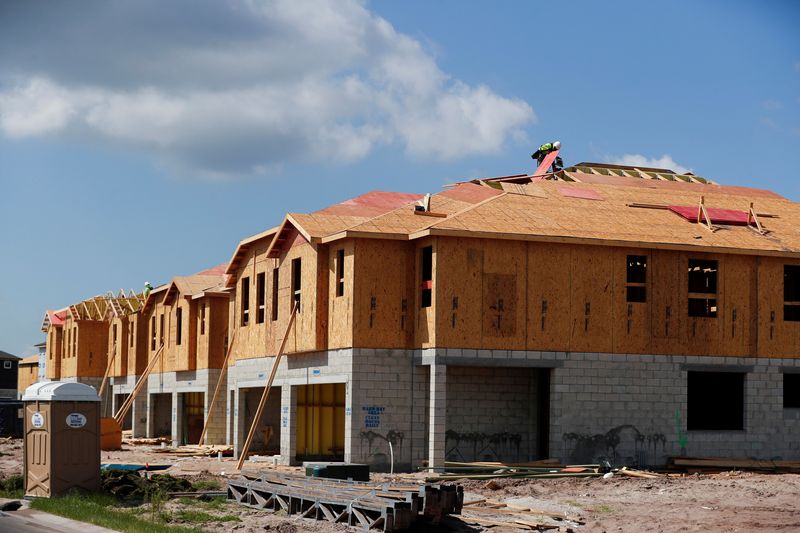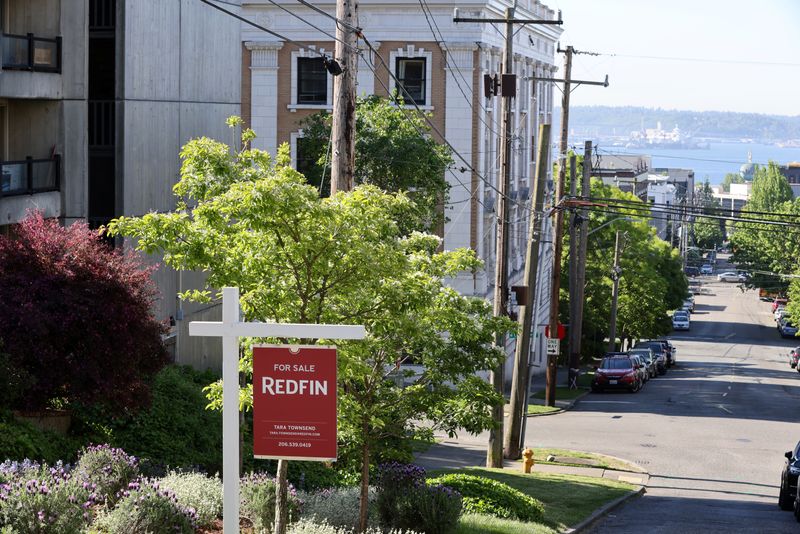By Lucia Mutikani
WASHINGTON (Reuters) - Sales of new U.S. single-family homes dropped to a six-month low in May as a jump in mortgage rates weighed on demand, offering more evidence that the housing market recovery was faltering.
But the sting from the largest decline in sales in more than 1-1/2 years, reported by the Commerce Department on Wednesday, was softened by a sharp upward revision to data for April, which now shows sales rising instead of falling as previously estimated. Supply was the highest in more than 16 years.
The housing market has been the sector hardest hit by the Federal Reserve's aggressive interest rate hikes since March 2022. It had, however, pulled out of the slump starting in the third quarter of last year as an acute shortage of previously owned homes boosted demand for new construction.
The resurgence in mortgage rates has also undercut sales of previously owned homes and homebuilding.
"As it stands, today's report will be further evidence to the Fed that monetary policy is restrictive and it will be time to start lowering rates in the coming months," said Richard de Chazal, macro analyst at William Blair.
New home sales declined 11.3% to a seasonally adjusted annual rate of 619,000 units last month, the lowest level since November, the Commerce Department's Census Bureau said. The percentage-based drop was the biggest since September 2022.
The sales pace for April was revised up to 698,000 units, a nine-month high, from a previously reported 634,000 units.
Economists polled by Reuters had forecast new home sales, which account for 13.1% of U.S. home sales, would hit a rate of 640,000 units.
New home sales are counted at the signing of a contract, making them a leading indicator of the housing market. They, however, can be volatile on a month-to-month basis. Sales slumped 16.5% on a year-on-year basis in May.
Residential investment notched double-digit growth in the first quarter, contributing to the economy's 1.3% annualized growth pace. Economists at Goldman Sachs trimmed their gross domestic product estimate for the second quarter to a 1.8% pace on the data from a 1.9% rate.
The average rate on the popular 30-year fixed-rate mortgage reached a six-month high of 7.22% in early May before retreating to 7.03% by the end of the month, data from mortgage finance agency Freddie Mac showed.
Financial markets expect the Fed to start cutting rates in September, though policymakers recently adopted a more hawkish outlook. The U.S. central bank has maintained its benchmark overnight interest rate in the 5.25%-5.50% range since July. It has raised its policy rate by 525 basis points since March 2022.
Stocks on Wall Street were trading higher. The dollar rose against a basket of currencies. U.S. Treasury prices fell.
BROAD SALES DECLINE
New home sales are likely to remain weak, with a report from the Mortgage Bankers Association on Wednesday showing applications for loans to purchase a home rose 1% last week on a seasonally adjusted basis from a week earlier.
"New home sales may continue to be subdued until we see a more substantial decline in mortgage rates," said Nancy Vanden Houten, lead U.S. economist at Oxford Economics. "We do expect a modest rebound in sales later in the second half of this year, when we look for mortgage rates to decline more decisively below 7% once Fed rate cuts get underway."
Sales plunged 43.8% in the Northeast and slipped 4.5% in the West last month. They plummeted 12.0% in the densely populated South and decreased 8.6% in the Midwest, which is viewed as a more affordable region.
The median new house price fell 0.9% to $417,400 in May from a year ago. Nearly half of the new homes sold last month were priced under $399,000.
A survey from the National Association of Homebuilders last week showed the share of builders cutting prices to bolster sales in June was the highest in five months. Builders are constructing smaller homes to try and fit home buyers' budgets.
National house prices are, however, steadily rising. The Federal Housing Finance Agency reported on Tuesday that single-family home prices increased 6.3% on a year-on-year basis in April.
There were 481,000 new homes on the market at the end of May, the highest level since January 2008 and up from 474,000 units in April, the Census report showed.

At May's sales pace it would take 9.3 months to clear the supply of houses on the market. That was the most months since November 2022 and up from 8.1 months in April. Rising supply could improve housing affordability.
"The overhang of new home listings will likely keep a lid on house price increases in the second half of 2024," said Bill Adams, chief economist at Comerica (NYSE:CMA) Bank. "That will make homebuying a little less unaffordable, and also contribute to cooler inflation in 2025."
